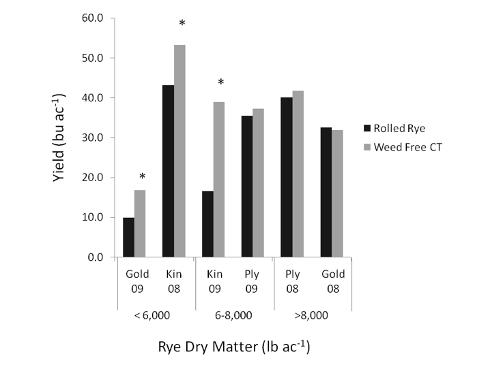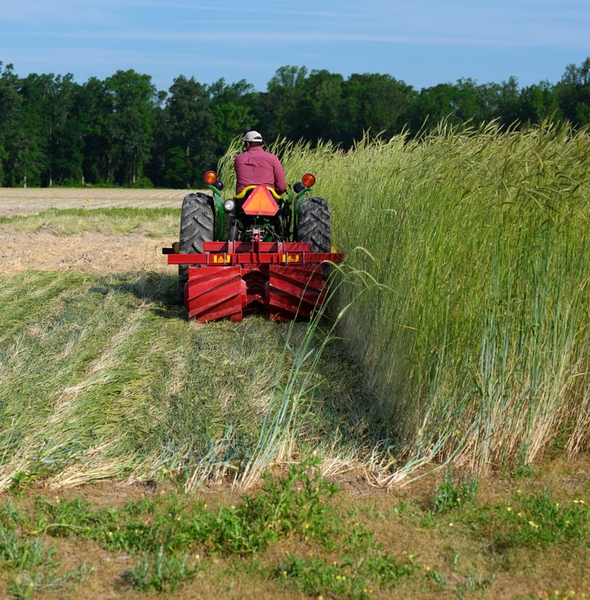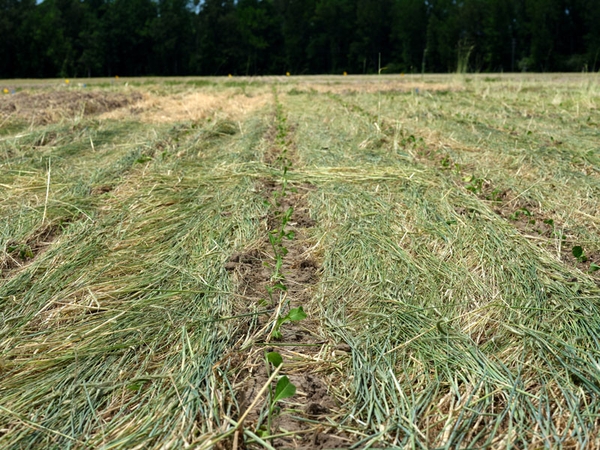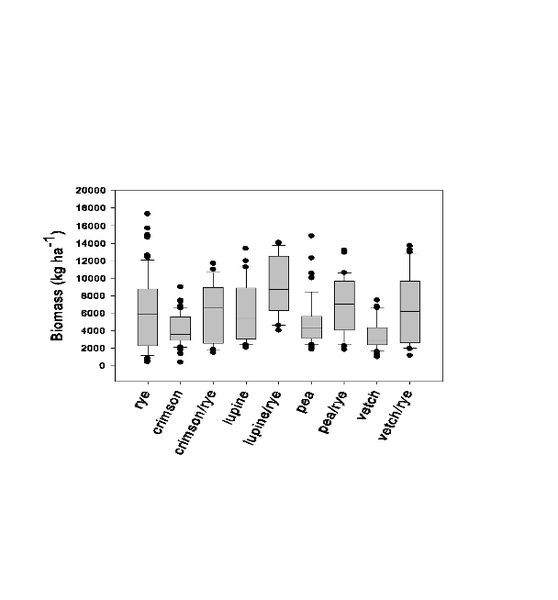Introduction
Cover crops are an important part of many organic producers’ crop rotations. Different cover crop species offer different benefits: legumes contribute nitrogen, which can be utilized by the following cash crop, and cereals provide weed suppression and erosion control due to their high biomass. Cover crops can help increase the diversity of crop rotations, allowing producers to prevent and break pest and disease cycles on their operation. There has been great interest in increasing acres under cover crops in recent years in both conventional and organic systems. However, adopting cover crops on an operation takes an investment of both time and money. In order to successfully incorporate cover crops in a rotation, a producer should take into consideration their current weed, pest, and disease pressure; crop rotation schedule; management goals; and their soil and climate. In this chapter, we will be highlighting recent research on the impact of cover crop incorporation in organic production systems and subsequent recommendations. These studies evaluate the benefits and challenges of using a cover crop in different commodity crop rotations.
Cover Crop Management in Organic Sweetpotato
Impact of Cover Crops and Varietal Resistance on Wireworm Pressure
Weed management is a significant challenge in sweetpotato systems. Winter cover crops provide an opportunity to suppress weeds through competition, allelopathy, and in a no-till system, a physical barrier of rolled mulch in the following season. There has been some reluctance to adopt cover crops in sweetpotato due to concerns that the cover crop will act as a “green bridge” or host for wireworms to feed on over winter. Wireworms are an economically significant pest in sweetpotato and there has been increasing work to develop varieties that have resistance to wireworm pressure.
A study conducted in 2018 and 2019 in Kinston and Goldsboro, North Carolina, evaluated the impact of cover crop management and sweetpotato variety selection on wireworm damage (Pellegrino, 2021). Trials included multiple cover crop species: cereal rye, a leguminous cover crop (hairy vetch or Austrian winter pea), as well as a mix of cereal rye and leguminous cover crop. The trial evaluated incorporating cover crops with conventional tillage as well as terminating using roller-crimping. Two varieties of sweetpotato were used: Covington, which is considered susceptible to wireworm; and Monaco, which is considered resistant to wireworm. Researchers measured wireworm presence using baits and assessed damage on sweetpotato at harvest.
In both years, variety resistance of sweetpotato and location had a significant relationship to wireworm damage. The Monaco variety in both locations had significantly less damage than Covington. Cover crop species and termination method did not show a significant impact on wireworm pressure in sweetpotato for both seasons. These results indicate that traditional winter cover crops for the Southeast (such as cereal rye, hairy vetch, peas) do not act as a green bridge. Instead, growers should focus on variety selection and crop rotation history to manage wireworms.
Cover Crop Management in Organic Flue-Cured Tobacco
Conservation Tillage in Organic Flue-Cured Tobacco
In the past decade, concerns over repeated intensive tillage compromising soil health have led to the increased adoption of conservation tillage strategies for many row crops. However, both conventional and organic tobacco acres have lagged in the adoption of reduced tillage due to concerns of insufficient weed control. The common practice of creating raised beds also increases the intensity of tillage in tobacco systems. Research has not shown drainage or yield benefits of growing tobacco on raised beds. Cover crops in organic systems can help reduce weed pressure, and in a reduced-tillage system, producers can plant crops directly into rolled cover crop biomass for continuous coverage.
In a two-year study, NC State researchers evaluated the potential for conservation tillage in organic tobacco (Machanoff, 2022). The researchers used cereal rye as a high-residue winter cover crop preceding flue-cured tobacco. Researchers were interested in understanding the effects of cover crop termination (conventional tillage versus roller-crimping) and field treatment (bedding versus flat ground) on weed pressure in-season, as well as tobacco yield and quality.
For the conventional tillage treatment, cereal rye was terminated by mowing in March, followed by disking in April (Figure 11-1). In the conservation tillage treatment, cereal rye was terminated using a single-row roller-crimper, with adaptations to maintain raised beds and tobacco transplants planted directly into rolled cover crop mulch using an adjusted transplanter (Figure 11-2).
Overall, plots that were under conservation tillage had significantly lower weed density than plots under conventional tillage, and within the plots that had cereal rye roller-crimped, weeds were better controlled between rows than within the row. There was not a significant difference between weed density in bedded and flat systems. Yields for the conservation tillage plots were higher than conventional tillage, and yields for the bedded tobacco system were higher than flat. Leaf quality was not significantly impacted by tillage treatment, and alkaloid sugars were slightly higher than optimum for both tillage systems and bedding treatments. This was likely due to a lack of adequate nitrogen earlier in the study.
Overall, good weed control was achieved using rolled cereal rye within the conservation tillage system, indicating potential for incorporation into organic systems. However, significant rain and standing water in the second year of research resulted in poor stands and an unharvestable crop. This highlights the challenges and risks of using conservation tillage. Tobacco is particularly sensitive to saturated soils. The inability to cultivate as a means to aerate soils is lost when using conservation tillage. In years with low-to-average precipitation, conservation tillage may be beneficial in reducing weed emergence, but when rain events are heavy or occur often, a grower may lose their crop.
Winter Cover Crop Management in Production of Organic Flue-Cured Tobacco
For successful flue-cured tobacco production, producers strive to have substantial nitrogen fertility available to the plant up front for growth and development, followed by little available nitrogen at and past flowering and topping. Organic sources of nitrogen must be mineralized in order to be plant available. This mineralization process is dependent on numerous environmental factors, such as temperature, soil moisture, and soil type. As such, nitrogen availability is less predictable when using organic fertilizers compared to conventional sources of nitrogen. A strategy for organic nitrogen delivery employed by many row crop growers is the use of leguminous cover crops; however, the use of leguminous cover crops has not been common in organic flue-cured tobacco production due to concerns of nitrogen management. Organic fertilizer such as sodium nitrate and pelletized poultry feather meal can be costly, and leguminous cover crops may offer soil health benefits and weed suppression as well as nitrogen, which could potentially supplement in-season applications.
Researchers investigated leguminous winter cover crops as a nitrogen source for flue-cured tobacco (Hahn, 2021). Field studies were conducted in Kinston and Rocky Mount, North Carolina, and three cover crops were compared: Austrian winter pea, crimson clover, and hairy vetch. Cover crops were accompanied by an in-season nitrogen application of 0%, 50%, and 100% of the recommended rate of nitrogen using pelletized poultry litter. The control treatment of no cover crop received 100% nitrogen rate.
Researchers noted differences in the carbon-to-nitrogen ratio of crimson clover from hairy vetch and Austrian winter pea, which is consistent with past literature. Hairy vetch and Austrian winter pea had a lower C:N ratio than crimson clover in both years at both locations. Biomass production varied for hairy vetch and crimson clover for 2018 and 2019, while Austrian winter pea produced consistent biomass. Maturity of the crimson clover likely reduced the biomass in 2019, and dry conditions during the winter of 2018 reduced the biomass of hairy vetch.
The nitrogen contributions of the cover crops across species were estimated using C:N ratio and biomass, Austrian winter pea contributed nitrogen most consistently due to consistent biomass and C:N ratio across years and contributed between 115 and 150 pounds of N per acre. While hairy vetch and crimson clover varied in nitrogen contributions in both years of the study at both locations, hairy vetch contributed at least 89 pounds of N per acre.
Measured soil nitrogen among species varied by location and year. Differences in weather patterns had an impact on the mineralization of nitrogen and decomposition of cover crop residue. Nitrogen of soil was measured at the time of fertilization, layby, and topping of tobacco. Researchers compared the impact of both cover crop species selection and cover crop use compared to the conventional control (no cover crop and 100% of nitrogen recommendation); different rates of nitrogen in addition to the cover crop treatment were also considered. There were minimal differences between treatments at the fertilization and layby time points between cover crop species, with the exception of higher inorganic nitrogen associated with the hairy vetch treatment. However, by flowering nitrogen rate had a significant effect on soil inorganic nitrogen, and cover crops impacted inorganic nitrogen levels. Hairy vetch continued to contribute nitrogen into the flowering period and this is a concern for tobacco leaf quality. The high biomass of hairy vetch likely contributed to its extended contribution to soil inorganic nitrogen.
Yield impacts from using cover crops and the nitrogen treatments varied based on year and location. In 2018, the use of cover crops did not impact yield in Rocky Mount, but in Kinston the use of cover crops increased yield compared to the conventional 100% NCC treatment. In 2019, rates of nitrogen had a significant impact on yield at both locations, but only in Kinston did cover crop treatment have an impact on yield; hairy vetch produced higher yields than crimson clover and the no-cover-crop treatment.
In 2018, only the Kinston location showed differences in leaf quality based on cover crop treatment. Hairy vetch resulted in lower leaf quality than crimson clover and the no-cover-crop treatment. In 2019, leaf quality was not influenced by cover crops.
The value of different cover crops considered the yield of tobacco and the leaf quality. Overall there was no significant difference between cover crop use and a conventional fertility program. At study sites in which hairy vetch decreased leaf quality, an increase in tobacco yield balanced the decreased value.
Overall the study showed promising possibilities for cover crops to help supplement nitrogen delivered by conventional fertility programs in organic flue-cured tobacco systems. The cost of seed ranged from $20 to $80 per acre, whereas pelletized poultry litter cost $530 per acre.
Rolled Cover Crops Mulches for Organic Corn and Soybean Production
Interest in cover crop mulches has increased out of both economic and soil conservation concerns. The number of tractor passes required to produce corn and soybeans organically is expensive and logistically challenging. Farmers currently use blind cultivators, such as a rotary hoe or flex tine harrow, two to five times, followed by two to four between-row cultivations (see the chapter in this guide on weed management). Repeated cultivations can be extremely effective but are highly sensitive to weather. During wet springs, cultivations are missed, leading to weedy fields. Soybeans are particularly troublesome when blind cultivations are missed. We cannot throw as much soil towards soybean plants as with corn, meaning in-row weeds missed by blind cultivation remain in the field until harvest time.
Killing Cover Crops Without Herbicides
Rolling cover crops has proven to be the most effective and inexpensive method for organic farmers to kill cover crops. Multiple designs for roller-crimpers exist (Figure 11-3) to accommodate flat or bedded plantings. Free designs are available from the Rodale Institute. The design advocated by Rodale is manufactured and sold by I&J Manufacturing of Gap, PA. Roller-crimper designs are engineered to maximize force on cover crop stems and to minimize vibrations on the tractor frame. Even so, farmers have reported occasional success using pre-existing equipment such as cultipackers and smooth rollers. A combination of the right cover crop growth stage and hot weather can result in a good kill without having the optimal equipment.
Cover crops must be at least flowering or in the early stage of seed set before they can be killed with a roller. Each species has its own set of characteristics to look for in determining when it can be roll-killed. Typical times and growth stage characteristics are listed in Table 11-1 and Table 11-2. Same-day rolling and planting has been advocated by some institutions. The roller can be mounted on the front of the tractor with the planter in the rear. While the number of trips is reduced, the soils are significantly drier at planting with the same-day approach. Researchers in Alabama, Georgia, and Maryland recommend rolling and waiting for rainfall to replenish soil moisture before planting. In North Carolina, only same-day planting has been tested so far, with good germination in soybean in seven out of nine trials, one of which had to be replanted to prevent total loss. Rolling and planting on different days presents a problem for farmers without GPS guidance. Rolling and planting must occur in the same direction, making the issue of what pattern to use when rolling and how to mark the passes with the planter a significant one.
Cover Crop Bloom Chart for North Carolina
These tables estimate the time of full bloom, or ideal time for rolling the crop to fully kill the cover crop so that corn or soybeans can be planted into the rolled mulch.
| Time * | Growth Stage | Species | Cultivar |
|---|---|---|---|
|
Late April/ early May |
100% Flower
|
Crimson clover
|
AU Robin
Dixie AU Sunrise Tibbee |
| Early pod set
|
Hairy vetch
|
AU Early Cover
|
|
| Late May
|
Early pod set
|
Hairy vetch
|
AU Merit
‘Steve Groff’ |
| Late May
|
Early pod set
|
Winter pea
|
variety unstated from NC
Whistler |
|
Early June |
Early pod set
|
Common vetch
|
variety unstated from NC
|
| 100% flower
|
Berseem Clover
|
Bigbee
|
* Timing can vary in unusual years ↲
| Time * | Cultivar |
|---|---|
| Late April
|
Wrens Abruzzi
Wrens 96 MatonII |
| Early May
|
Aroostook
|
| Mid-to-late May
|
Rymin
Wheeler |
* Timing can vary in unusual years ↲
Planters
Several features of a no-till planter are essential for such a high residue environment:
- Straight-edged no-till coulters. Fluted edges lead to hair-pinning of the cover crop into the seed trench. Straight edges with bubbles or flutes are ok and help to loosen the germination zone on some soils.
- Heavy duty downforce springs or a pneumatic downforce system is often needed.
- Some planters may need extra weight mounted on the frame. If fertilizer or insecticide boxes are unused, they can be filled with sandbags.
- The best type of closing wheel for this system is still being debated. Even with the heaviest of closers, sealing the trench can be difficult at times.
Weed Control
To get consistent weed control and good soybean yields, more than 8,000 pounds of rye dry matter are needed (Figure 11-4). Early planting and adequate fertility are required to obtain this level of production, and even then, overly wet winters inhibit rye growth. Walking the fields in March is recommended to assess whether the stand is sufficient for good rye production. Poor or spotty stands should be disked in and a clean tillage system used. If rye becomes too large before disking, it can be difficult to prepare a clean seed bed and to cultivate.
Less is known about the performance of legume-corn systems here in terms of weed control. Mixtures of legumes and rye are capable of producing more than 8,000 pounds of dry matter (Figure 11-5). Whether this 8,000-pound cut-off applies to legume-corn systems is still unknown.
Figure 11-5. Productivity of legumes and legume-cereal mixes in the Southeast from 2008 to 2010. Figures come from a pooled analysis of trials in Georgia (GA) and North Carolina (NC). Box plots were created from nine site-years for all cover crops except lupine and lupine/rye, with four to six replicates per site-year. Lupine data is from GA only (five site-years) due to extremely low productivity in NC. Crimson clover varieties: Trifolium incarnatum L. “AU Sunrise” in NC; “Dixie” in GA. Vetch varieties: Vicia villosa Roth “AU Early Cover” in NC; Vicia sativa L. “Cahaba White” in GA. Winter pea varieties: Pisum sativum L. subsp. sativum var. arvense (L.) Poir “variety unstated” in NC and GA. Narrow-leaf lupine varieties: Lupinus angustifolius L. “TifBlue 78” in NC and GA. NC data adapted from Parr et al. 20115. Rye (Secale cereale L.) at both locations was “Wrens abruzzi,” grown without added N fertility.

Figure 11-4. Soybean yield in roll-crimped rye mulches at test sites in Goldsboro, Kinston, and Plymouth, North Carolina, in 2008 and 2009. Treatments consisted of rolled rye mulch with no additional weed control measures versus a weed-free check that consisted of conventional tillage with S-metoloachlor PRE and imazethpyr POST.
Adapted from Smith et al. 2011.
Nitrogen Fertility in the Legume-Corn System
Legumes can be grown in a monoculture or as a mixture with a small grain. Legumes are capable of providing a substantial proportion of the N needed for corn. While N production varies significantly from year to year, a good rule of thumb is that the legume can provide 2/3 of the needed nitrogen. Pelleted organic fertilizer can be applied at planting in only limited amounts with normal granular fertilizer boxes. For instance, John Deere granular boxes, with the high-rate auger installed, can deliver approximately 700 pounds of conventional fertilizer at the highest setting. Pelleted feather meal, as an example, is less dense and only 500 pounds can be delivered. At 12% to 13% N, the total N that can be applied is 65 pounds. Assuming adequate legume cover crop growth, this may be sufficient. Other organic fertilizers are less rich in N, such as pelleted chicken litter, and therefore even less N can be applied. Some companies sell organic fertilizer boxes capable of applying higher rates of granular and pelletized material than conventional fertilizer boxes. Another option is to broadcast chicken litter over the top at or soon after planting. While this practice would be allowed for feed crops, manures must be soil-incorporated at least 90 days before harvest for all food grade grains.
References
Hahn, S.L., A.L. Woodley, and M.C. Vann. 2021. “Winter Cover Crop Management in the Production of Organic Flue-Cured Tobacco.” Agronomy Journal 113: 2698–2709.
Machanoff, C.H., M.C. Vann, A.L. Woodley, and D. Suchoff. 2022. “Evaluation of Conservation Tillage Practices in the Production of Organic Flue-Cured Tobacco.” Agrosystems, Geosciences & Environment, 5, e20317.
Pellegrino, A.M., A.L. Woodley, and A.S. Huset. 2021. “Understanding the Relationship Between Wireworm (Coleoptera: Elateridae) Damage, Varietal Resistance, and Cover Crop Use in Organic Sweetpotato,” Journal of Economic Entomology 114 (5): 2127–2134.
Acknowledgment of Previous Contributing Authors
Steven Mirsky, Research Ecologist, USDA-ARS
John Spargo, Extension, University of Massachusetts
Julie Grossman, Professor, University of Minnesota
Ted Kornecki, Agricultural Engineer, USDA-ARS
Ted Webster, Research Agronomist, USDA-ARS
Andrew Price, Plant Physiologist, USDA-ARS
Alan Meijer, Former Soil Science Extension Associate, NC State University
George Place, Former Crop Science Research Associate, NC State University
Publication date: March 19, 2024
AG-660
Other Publications in North Carolina Organic Commodities Production Guide
- Chapter 1: Introduction
- Chapter 2: Organic Crop Production Systems
- Chapter 3: Crop Production Management - Corn
- Chapter 4: Crop Production Management - Wheat and Small Grains
- Chapter 5: Crop Production Management - Organic Soybeans
- Chapter 6: Crop Production Management - Flue-Cured Tobacco
- Chapter 7: Crop Production Management - Peanuts
- Chapter 8: Crop Production Management - Sweetpotatoes
- Chapter 9: Soil Management
- Chapter 10: Weed Management
- Chapter 11: Rolled Cover Crop Mulches for Organic Corn and Soybean Production
- Chapter 12: Organic Certification
- Chapter 13: Marketing Organic Grain Crops and Budgets
- Chapter 14: Organic Market Outlook and Budgets
- Chapter 15: Resources for More Information on Organic Commodity Production
N.C. Cooperative Extension prohibits discrimination and harassment regardless of age, color, disability, family and marital status, gender identity, national origin, political beliefs, race, religion, sex (including pregnancy), sexual orientation and veteran status.




